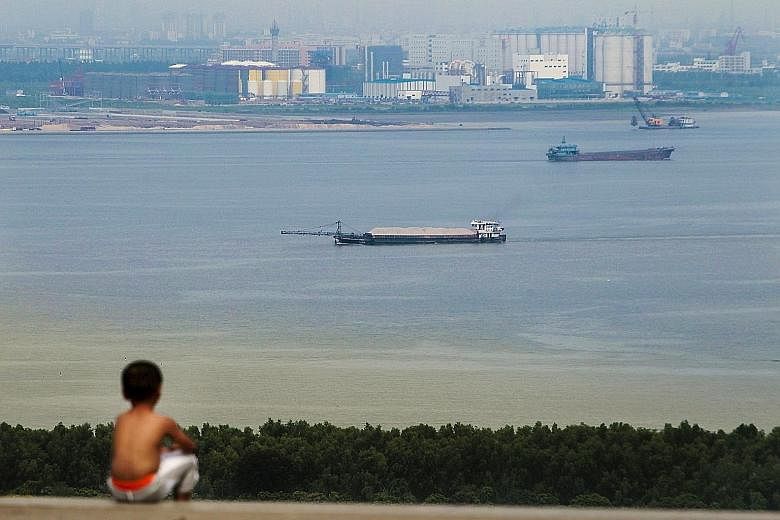BEIJING • For centuries, the southern province of Guangdong has been at the forefront of China's economic evolution.
Emperor Qianlong, in the 18th century, made the provincial capital Guangzhou - then known as Canton - the only port to allow foreign trade. When the Communist Party came to power in the middle of the last century, the Canton Fair remained a window to Red China.
And when former leader Deng Xiaoping needed a testing ground for market-based reforms in the early 1980s, he chose the Pearl River Delta.
Investment and cheap workers flowed in from across China, and cheap exports poured out. The resulting "Guangdong miracle" brought average annual double-digit growth rates for 35 years.
Today, as the manufacturing-based model reaches its use-by date, the province is seeking a new future for its US$1 trillion (S$1.4 trillion) economy and the nation's, too. The plan centres on innovation, services and a "new normal" of slower, more sustainable expansion.
"As a leading province in China's opening up and reform, Guangdong's economy has entered the 'new normal' at an earlier stage," provincial governor Zhu Xiaodan told Bloomberg in a rare, 31-page written interview. "Since we entered the new stage earlier, we should adapt to it earlier, so that we can play a leading role. That's the meaning of being (in the) vanguard."
The province - with an economy bigger than Indonesia's and more people than Germany - has already made inroads, spawning companies such as Huawei Technologies, the nation's largest maker of telecommunications equipment, and Tencent Holdings, which operates the WeChat instant-messaging service and online banks, and plans to make movies.
"You can use Guangdong as the window to peer into China's economic future," said Mr Zhao Yang, the chief China economist at Nomura Holdings in Hong Kong. "It's quite possible Guangdong will find a new growth model for China that relies more on innovation."
The province has shut down swathes of heavy industrial capacity, built up the services sector, and raised investment in research and development, in its second-largest city of Shenzhen, to a level approaching that of South Korea's. This week, HSBC Holdings became the latest to endorse Guangdong's strategy, in planning to add 4,000 jobs in the region.
The challenges facing Mr Zhu in Guangdong resemble those confronting Chinese President Xi Jinping, as he tries to shift the world's second-biggest economy away from cheap labour, and debt-fuelled capital spending.
The governor said Mr Xi wants Guangdong - which accounts for about one-tenth of the national economy, one-eighth of fiscal revenues and a quarter of foreign trade - to set an example for the nation.
Speaking in Seattle on the first day of a week-long visit to the United States, Mr Xi told a gathering of business leaders that China would never close its doors to the outside world, and would rely on "reforms" to keep a medium to high growth rate, despite slowdown pressures.
The preliminary reading of a private Chinese manufacturing gauge fell to the lowest in more than six years yesterday, underscoring challenges facing the nation as its old growth engines splutter.
Guangdong has promised Premier Li Keqiang local economic growth exceeding the national average, and fiscal revenue that's "significantly" higher, said Mr Zhu, 62, who has spent his whole career in the province, including a stint in a musical instrument factory during the Cultural Revolution. Underscoring his vision for the province's leading role, Mr Zhu used the word "vanguard" 10 times in his response.
Guangdong's old growth model was to "lend the place to other people to play", by luring migrant workers from inland provinces and money from Taiwan, said Mr Andy Xie, an independent economist who was previously Morgan Stanley's chief Asia-Pacific economist. As China's labour pool shrinks, and the younger generation eschews work on the factory floor, Guangdong will be in for a bumpy ride, Mr Xie said.
Mr Zhu, who was acting governor in 2011 before taking the role in 2012, has overseen a deceleration in growth. The provincial economy expanded by 7.8 per cent last year, and 7.7 per cent in the first half of this year, down from 12.2 per cent in 2010. He said Guangdong faces the prospect of a "shrinking labour supply and an ageing population".
The province is opening doors to let some migrant workers become permanent residents, giving them more access to local education, pension, and health coverage.
"The better that Guangdong is doing economically, the more that it can be advertised by people like its party secretary and governor," said Mr Louis Kuijs, the head of Asia economics at Oxford Economics in Hong Kong. "They've made good initial steps on both the policy front and the economy, but there are serious challenges ahead."
BLOOMBERG

